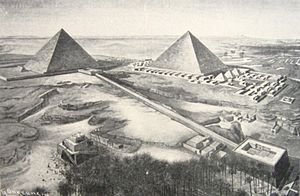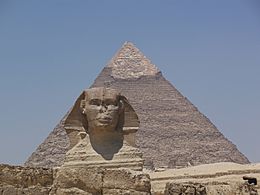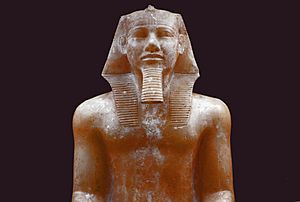Khafre facts for kids
Quick facts for kids Khafre |
|
|---|---|
| Khefren, Suphis II, Saophis | |
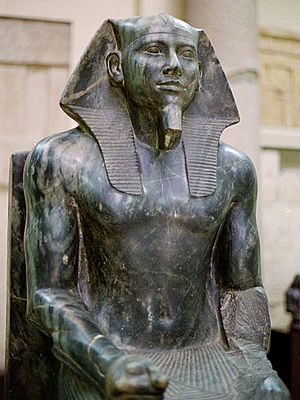
Khafre Enthroned, a funerary statue of Khafre in diorite. Egyptian Museum in Cairo
|
|
| Pharaoh | |
| Reign | About 26 years, ca. 2570 BC (4th Dynasty) |
| Predecessor | Djedefre |
| Successor | Bikheris (?), Menkaure |
| Consort | Meresankh III, Khamerernebty I, Persenet, Hekenuhedjet |
| Children | Nebemakhet, Duaenre, Niuserre, Khentetka, Shepsetkau, Menkaure, Khamerernebty II, Sekhemkare, Nikaure, Ankhmare, Akhre, Iunmin, Iunre, Rekhetre, and Hemetre |
| Father | Khufu |
| Mother | Meritites I or Henutsen |
| Burial | Pyramid of Khafre |
| Monuments | Pyramid of Khafre |
Khafre (also known as Khephren) was an ancient Egyptian king, or pharaoh. He ruled during the 4th Dynasty in a period called the Old Kingdom. He was the son of Khufu, another famous pharaoh. Khafre became king after his brother, Djedefre.
Khafre is most famous for building the second largest pyramid at Giza. Many experts also believe that the famous Great Sphinx was built for him around 2500 BC. Not much is known about Khafre's life directly from his time. Most of what we know comes from later historians.
Contents
Who Was Khafre's Family?
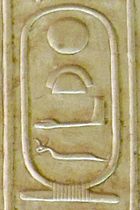
Khafre was the son of King Khufu. Khufu was the pharaoh who built the Great Pyramid of Giza. Khafre also had a brother named Djedefre, who ruled before him.
Some people think Khafre's mother was Queen Meritites I. This is because an old writing says he honored her. Others believe his mother might have been Queen Henutsen.
Khafre had many wives and children. He had at least 12 sons and 3 or 4 daughters. Here are some of his important family members:
- Queen Meresankh III was Khafre's niece. She was the mother of several of his sons, including Nebemakhet and Duaenre. She also had a daughter named Shepsetkau.
- Queen Khamerernebty I was the mother of Menkaure. Menkaure later became a pharaoh himself.
- Hekenuhedjet was another wife of Khafre. Her son was named Sekhemkare.
- Persenet might have been a wife of Khafre. Her son was Nikaure.
Other children of Khafre are known, but we don't know who their mothers were.
How Long Did Khafre Rule?
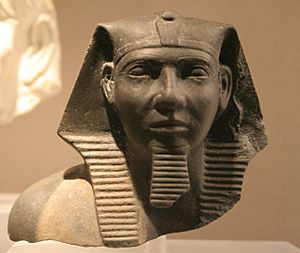
Historians don't fully agree on the exact dates of Khafre's rule. Some say he ruled from 2558 BC to 2532 BC. Ancient records are not always clear. One old list, the Turin King List, doesn't say how long he ruled. Another historian, Manetho, said Khafre ruled for 66 years, but this is likely too long.
Most experts believe Khafre ruled for about 24 to 26 years. This idea comes from old writings found in tombs. For example, a will from his son, Prince Nekure, is dated to the "Year of the 12th Count." If these "counts" (which were like censuses or tax collections) happened every two years, it would mean a long reign for Khafre.
Khafre's Amazing Pyramid Complex
Khafre built the second-largest pyramid at Giza. Its ancient Egyptian name was Wer(en)-Khafre, which means "Khafre is Great." This shows how important the pharaoh was.
Next to Khafre's main pyramid, there is a smaller pyramid. It is called GII a. We are not sure who was buried there. Some clues suggest it might have been for an important son of the king.
What Was the Valley Temple?
Khafre's valley temple was built closer to the Nile River. It was likely right next to the Sphinx temple. This temple was probably used for special ceremonies. Inside, archaeologists found statues of Khafre. Some were headless, but others were complete. These statues help us imagine what Khafre looked like.
What Was the Mortuary Temple?
The mortuary temple was built very close to Khafre's pyramid. This temple was used for rituals and offerings to the pharaoh after he died. Pieces of objects with Khafre's name have been found here.
The Great Sphinx and Its Temple
The famous Great Sphinx is believed to have been built during Khafre's time. It stands very close to Khafre's pyramid complex. The face of the Sphinx even looks a bit like statues of Khafre.
The Great Sphinx of Giza might have been carved to guard Khafre's pyramid. It also served as a powerful symbol of the king's strength. Later, during the New Kingdom, people even worshipped the Sphinx as a god.
Khafre in Ancient Greek Stories
Ancient Greek historians wrote about Khafre many years after he lived. For example, Manetho called him "Sûphis II." and said he ruled for 66 years.
Other Greek historians like Diodorus and Herodotus wrote about Khafre too. They said he was a harsh ruler, like his father Khufu. They also said Khafre ruled for 56 years.
These Greek stories also mention King Menkaure, who ruled after Khafre. They described Menkaure as a good king who brought peace back to Egypt.
Today, many experts think these Greek stories might not be fully true. The Greeks might have seen the huge pyramids and thought they must have been built by cruel kings. They might have misunderstood the ancient Egyptian culture. The Greeks also liked to tell exciting stories, and tales of powerful, strict rulers were popular.
Khafre's Statues
Khafre has more statues found than almost any other ruler from the Old Kingdom. Most of these statues were found at Giza, especially around his pyramid temples.
In a large room of his valley temple, there were 23 special spots on the floor. Life-size statues of Khafre once stood in these spots. One spot was wider, possibly for two statues. Some people think these 24 statues might have represented the hours of the day.
Over time, these statues were moved from their original places. In 1860, an archaeologist named Auguste Mariette found nine of them in a pit within the valley temple. These amazing statues are now kept in the Egyptian Museum in Cairo.
See also
 In Spanish: Kefrén para niños
In Spanish: Kefrén para niños


